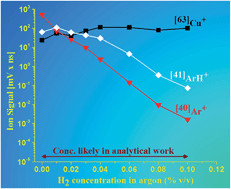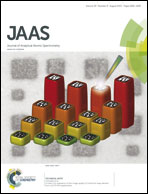A glow discharge time-of-flight mass spectrometry (GD-TOFMS) study of the ‘hydrogen effect’ using copper, iron and titanium cathodes
Abstract
We report TOFMS investigations on the effects of hydrogen added to a dc GD argon plasma, in detail over the most likely concentration range occurring in analytical work (0–0.10% v/v), together with an overview to 0.8% v/v; typical GD-OES discharge conditions were used. Many previous studies on the effects of hydrogen in analytical GD-MS used much higher hydrogen concentrations. In this paper, we report for the first time the ‘hydrogen effect’ on relative ion signal intensities of matrices, plasma and added gas, for very low but analytically important hydrogen concentrations. We investigate the behavior of doubly charged argon ions (Ar++), dimer ions (Cu2+, Fe2+, Ti2+, Ar2+) and polyatomic ions (ArH+, CuH+, FeH+, TiH+), which can play important roles in plasma processes. We discuss the probable discharge mechanisms in order to gain a greater understanding of the fundamental processes involved in the ionization of the species observed in this study and their likely effects on analytical results. We propose a mechanism to explain the increase in the matrix signal which occurs if an argon/hydrogen mixture is used as the plasma gas.

- This article is part of the themed collection: JAAS Emerging Investigator Lectureship winners

 Please wait while we load your content...
Please wait while we load your content...